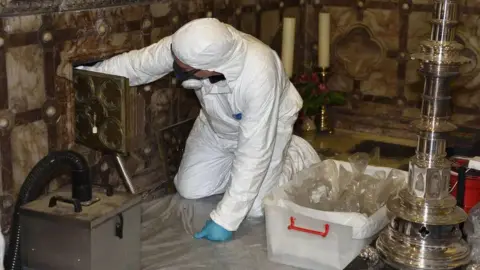Bones of 7th Century saint finally laid to rest
 BBC/Jo Burn
BBC/Jo BurnThe bones of a 7th Century saint will be finally laid to rest in Folkestone on Sunday after being formally identified as St Eanswythe.
The relics of the town's patron saint were hidden in the wall of the church of St Mary and St Eanswythe during the Reformation and rediscovered in the 1800s.
Scientists removed the bones from the church wall in 2020 for carbon dating, and it was revealed they were those of St Eanswythe - one of the earliest English saints.
The remains have now been transferred into a newly designed reliquary - a container specifically for relics - and will be put back in the wall.
It marks the end of the Finding Eanswythe Project, which discovered that the remains were female and dated from the years 631- 641 AD.
St Eanswythe, a Kentish royal saint descended from Anglo-Saxon kings, is believed to have founded one of the earliest monastic communities in England in about 660 AD.
 Mark Hourahane
Mark HourahaneHer miracles included appearing to make water run uphill.
Dr Andrew Richardson, from the Canterbury Archaeological Trust, said that he and the archaeological team who handled her bones for examination were conscious of the sensitive nature of the work.
“We moved into the church and set up a lab and we examined both the bones and the lead container they had been stored in," he told BBC Radio Kent.
“When I got the radiocarbon dates, I was nervous when I opened the e-mail to see what those dates would be.”
The reliquary will be placed inside the wall where the bones were found in the 1800s.
The exact date the bones were rediscovered is disputed, with claims they were found in 1835, 1855 and 1885.
Follow BBC Kent on Facebook, on X, and on Instagram. Send your story ideas to [email protected] or WhatsApp us on 08081 002250.
